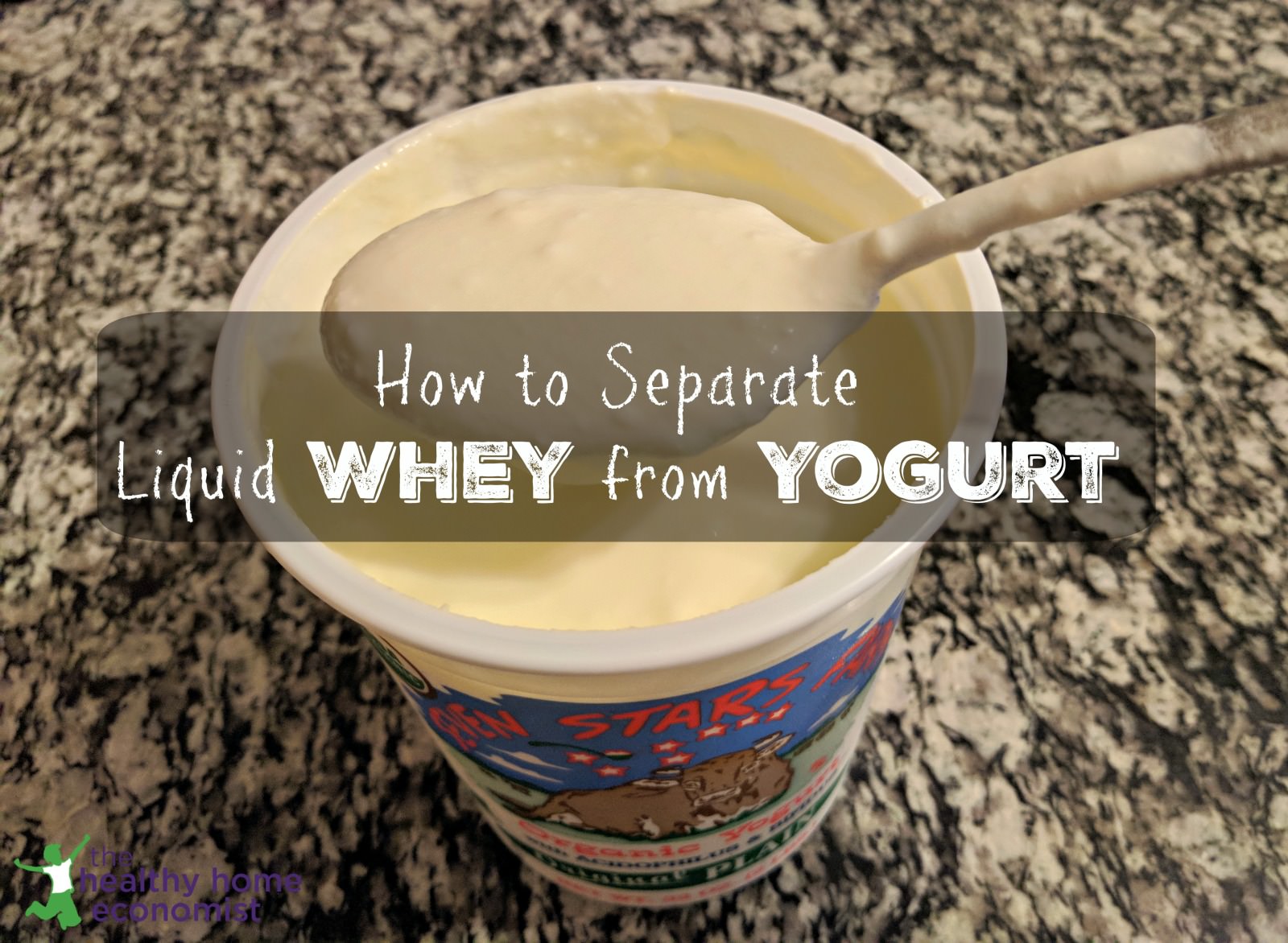Table of Contents[Hide][Show]
 Whey in its liquid and whole food form is the ideal starter for probiotic-rich, health-enhancing fermented foods and drinks.
Whey in its liquid and whole food form is the ideal starter for probiotic-rich, health-enhancing fermented foods and drinks.
Liquid whey is most easily and economically obtained from soured raw milk also called clabbered milk.
Clabbered milk is a very useful item for the traditionally minded cook and has the consistency and taste of drinkable style yogurt.
Unfortunately, not everyone has access to raw milk which may seem to preclude the use of unprocessed, liquid whey for fermentation purposes as it is not commercially available.
The good news is that you can easily extract whey from plain yogurt from the store. Using homemade yogurt is even better. You may use Greek yogurt too although you won’t get as much whey from the effort. This is due to the nutritional differences of Greek yogurt vs regular yogurt.
Powdered Whey No Substitute for the Real Thing
Please note that powdered whey is never an adequate substitute for whole, unprocessed, liquid whey. To gain the benefits of whey, it must be gently separated from a fermented dairy product like clabbered milk, kefir, or yogurt.
Drying and powderizing whey even at low temperatures denature the delicate proteins. It also eliminates the beneficial probiotic and enzymatic properties.
Uses for Liquid Whey
Liquid whey is an important ingredient in homemade baby formula recipes. In addition, it is indispensable as an inoculant for fermented foods and drinks. Unprocessed liquid whey is also wonderful to mix with filtered water and a little orange juice for a healthy sports drink naturally loaded with electrolytes.
How to Separate Whey from Yogurt (or Kefir)
The easy recipe below will result in a jar of beautiful raw whey within minutes! You won’t believe how easy it is! I recommend that you do not use Greek yogurt, as it contains significantly less whey than regular yogurt.
I also recommend that you stick with quality yogurt brands as there is quite a bit of variation within the industry.

How to Separate Whey from Yogurt
Simple how-to for separating whey from yogurt or kefir. Homemade or store bought brands may be used including whole, lowfat, and no fat versions. Whole yogurt is recommended, however.
Ingredients
- 1 quart plain yogurt kefir may be substituted
- 1 large glass bowl
- 1 fine mesh cheese cloth
- 1 large rubber band
Instructions
-
Line bowl with cheesecloth. Spoon in the container of yogurt.
-
Gather up the ends of the cheesecloth and secure with the rubber band. Attach the rubber band to a knob on one of your upper kitchen cabinets. Keep the bowl beneath to catch the dripping whey.
-
Leave dripping on the counter for about 1 hour.
-
Remove drip bag from the kitchen knob and place in a clean bowl. Unfasten the rubber band and scrape out the yogurt cheese within the cheesecloth into a container. Seal the lid and refrigerate.
-
Pour the liquid whey in the first bowl into a glass mason jar and secure the lid. Refrigerate. It will stay fresh for several months.
Separating Whey from Yogurt (Video Tutorial)
In the video below, I show you the very easy process for obtaining whey in its liquid, whole food form from a quart of plain yogurt. I also discuss what to do with the leftover yogurt cheese once the whey has been extracted. Hint: it makes a delicious stuffing for large pasta shells or lasagna.
Note that you can use kefir in place of yogurt if desired. Use the exact same process shown in the video. Kefir is healthier than yogurt too, containing far more beneficial probiotics. Unfortunately, it is harder to find quality brands commercially, but fortunately, kefir is easier to make at home than yogurt if that’s what you’d really prefer to use.
If using yogurt, you are going to want to source the best quality your budget can afford. Ideally, this is grass-fed organic whole yogurt. But, in a pinch, you can use no fat or low-fat yogurt from supermarket brands like Dannon.
Cloudy or clear liquid whey will last in a glass mason jar in the refrigerator for about six months. Note, however, that the flavor will grow stronger and more pungent over time.








Hey Sarah,
Long time follower, wanted to ask if I could make risotto in the crockpot with homemade bone broth and butter and cheese. Would that be a healthy dish because of good fat and broth with white rice?
I just recently heard that it is possible to use powder from a probiotic capsule mixed with water for fermenting, though less desirable than using whey. At the time, I did not realize pasteurized, store bought yogurt would also be an acceptable method for making liquid whey. My question is, if this is your only option, would it be advisable to add some probiotic powder like Biokult to this yogurt-derived whey? If so, how much and at what point in the process?
Is it possible to use coconut yogurt like this to extract whey? And could you use coconut whey to ferment vegetables?
Hi Sara! Thanks for this video. I’m lactose-intolerant, and yogurt is the only dairy product I can really handle. I’m wondering about the “yogurt cheese” leftover after this process – do you think it still has enough lactase that I could eat it, or are all those lactose-eating bacteria dripping out with the whey?
Wikipedia says, “After the curdling process, lactose is found in the water-based portion (along with whey and casein), but not in the fat-based portion.” So, it seems that lactose is a water-soluble molecule, and would thus be concentrated in the whey (rather than the yogurt cheese). Hopefully much of the lactase stays in the yogurt cheese to deal with any leftover lactose?
Does that sound right to you? If you have any further knowledge about the lactose content of “yogurt cheese,” please let me know! Thanks!
Sarah, I love your videos! I was wondering why it is OK to use the left over yogurt from making the whey, isn’t it pasteurized and therefore cause problems to your body systems? Sorry I just wanted to figure out how it is still good for your body not being from raw milk. Thanks for all your help.
It’s not optimal to use pasteurized cheese but it is fine to use if that is all a person has access to.
This is very useful information for me. I go through a ton of powdered whey. I have even more research to do now. Thanks for this
Do I need to set the yogurt out to get room temperature before straining out the whey?
Maygan,
No, you don’t need to bring the yogurt to room temp before beginning to strain the whey. Leaving it overnight – whether on the counter or in the frig – ensures all the whey has been drained.
Perfect timing! I just defrosted some Raw Goat milk which separated big big time! I was looking for what to do. Oh just a tidbit to get your hackels up this latest advice from the ADA…ADA Recommends Fluoride Toothpaste As Soon As First Tooth Comes In. Sarah, thanks for such a great blog!
I make kefir cheese save whey from kefir. Can be frozen to.
I was just about the ask if I could use whey from kefir cheese. Thanks for posting!
I so appreciated this video!
Thank you!